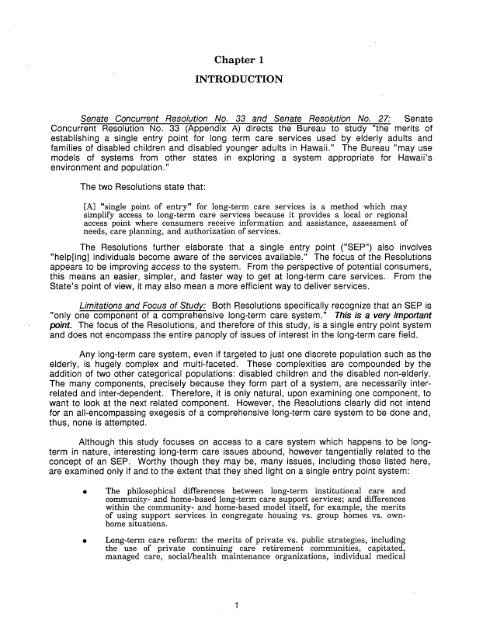long-term care - Legislative Reference Bureau
long-term care - Legislative Reference Bureau
long-term care - Legislative Reference Bureau
Create successful ePaper yourself
Turn your PDF publications into a flip-book with our unique Google optimized e-Paper software.
Chapter 1<br />
INTRODUCTION<br />
Senate Concurrent Resolution No. 33 and Senate Resolution No. 27: Senate<br />
Concurrent Resolution No. 33 (Appendix A) directs the <strong>Bureau</strong> to study "the merits of<br />
establishing a single entry point for <strong>long</strong> <strong>term</strong> <strong>care</strong> services used by elderly adults and<br />
families of disabled children and disabled younger adults in Hawaii." The <strong>Bureau</strong> "may use<br />
models of systems from other states in exploring a system appropriate for Hawaii's<br />
environment and population."<br />
The two Resolutions state that:<br />
[A] "single point of entry" for <strong>long</strong>-<strong>term</strong> <strong>care</strong> services is a method which may<br />
simplify access to <strong>long</strong>-<strong>term</strong> <strong>care</strong> services because it provides a local or regional<br />
access point where consumers receive information and assistance, assessment of<br />
needs, <strong>care</strong> planning, and authorization of services.<br />
The Resolutions further elaborate that a single entry point ("SEP") also involves<br />
"helpring] individuals become aware of the services available." The focus of the Resolutions<br />
appears to be improving access to the system. From the perspective of potential consumers,<br />
this means an easier, simpler, and faster way to get at <strong>long</strong>-<strong>term</strong> <strong>care</strong> services. From the<br />
State's point of view, it may also mean a more efficient way to deliver services.<br />
Limitations and Focus of Study: Both Resolutions specifically recognize that an SEP is<br />
"only one component of a comprehensive <strong>long</strong>-<strong>term</strong> <strong>care</strong> system." This is a vel}' important<br />
point. The focus of the Resolutions, and therefore of this study, is a single entry point system<br />
and does not encompass the entire panoply of issues of interest in the <strong>long</strong>-<strong>term</strong> <strong>care</strong> field.<br />
Any <strong>long</strong>-<strong>term</strong> <strong>care</strong> system, even if targeted to just one discrete population such as the<br />
elderly, is hugely complex and multi-faceted. These complexities are compounded by the<br />
addition of two other categorical populations: disabled children and the disabled non-elderly.<br />
The many components, precisely because they form part of a system, are necessarily interrelated<br />
and inter-dependent. Therefore, it is only natural, upon examining one component, to<br />
want to look at the next related component. However, the Resolutions clearly did not intend<br />
for an all-encompassing exegesis of a comprehensive <strong>long</strong>-<strong>term</strong> <strong>care</strong> system to be done and,<br />
thus, none is attempted.<br />
Although this study focuses on access to a <strong>care</strong> system which happens to be <strong>long</strong><strong>term</strong><br />
in nature, interesting <strong>long</strong>-<strong>term</strong> <strong>care</strong> issues abound, however tangentially related to the<br />
concept of an SEP. Worthy though they may be, many issues, including those listed here,<br />
are examined onfy if and to the extent that they shed light on a single entry point system:<br />
• The philosophical differences between <strong>long</strong>-<strong>term</strong> institutional <strong>care</strong> and<br />
community- and home-based <strong>long</strong>-<strong>term</strong> <strong>care</strong> support services; and differences<br />
within the community- and home-based model itself, for example, the merits<br />
of using support services in congregate housing vs. group homes vs. ownhome<br />
situations.<br />
• Long-<strong>term</strong> <strong>care</strong> reform: the merits of private vs. public strategies, including<br />
the use of private continuing <strong>care</strong> retirement communities, capitated,<br />
managed <strong>care</strong>, sociallhealth maintenance organizations, individual medical<br />
1
















